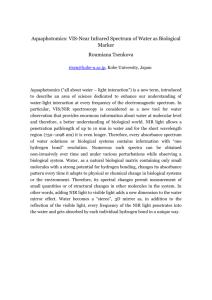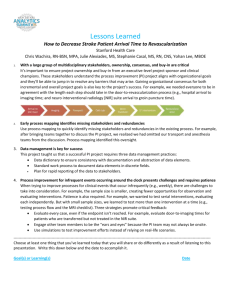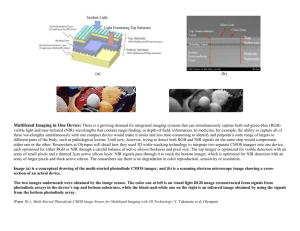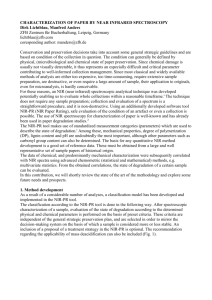CONSTRUCTION AND APPLICATION OF SATELLITE IMAGE 3D PRESENTATION SYSTEM FOR EDUCATION
advertisement
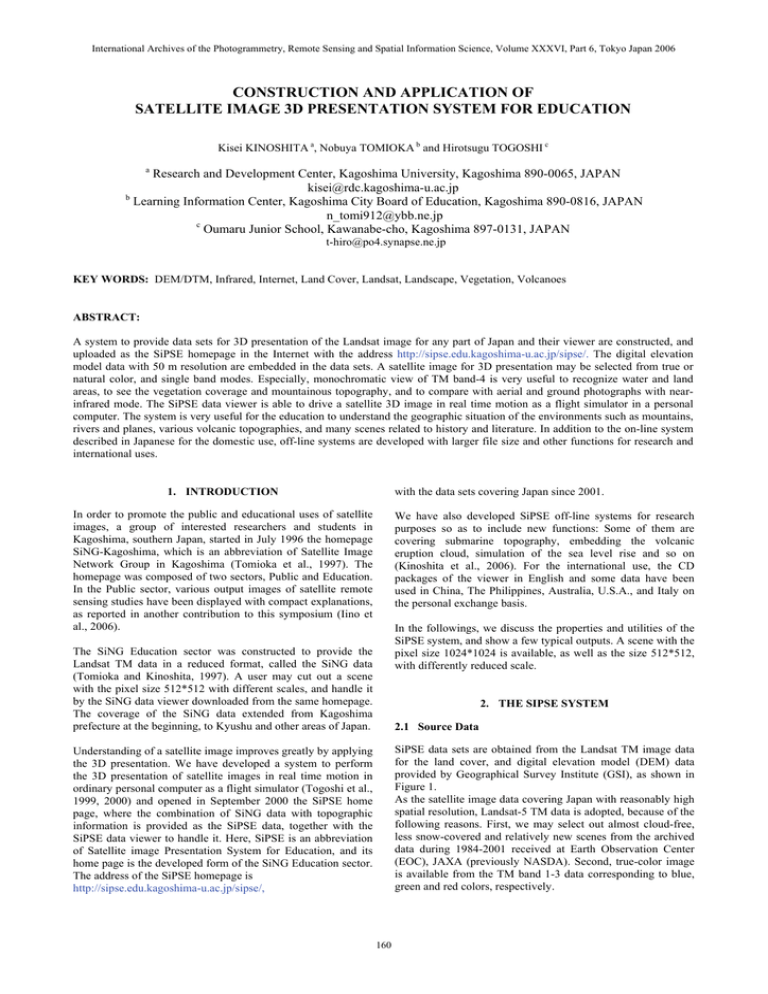
International Archives of the Photogrammetry, Remote Sensing and Spatial Information Science, Volume XXXVI, Part 6, Tokyo Japan 2006 CONSTRUCTION AND APPLICATION OF SATELLITE IMAGE 3D PRESENTATION SYSTEM FOR EDUCATION Kisei KINOSHITA a, Nobuya TOMIOKA b and Hirotsugu TOGOSHI c a Research and Development Center, Kagoshima University, Kagoshima 890-0065, JAPAN kisei@rdc.kagoshima-u.ac.jp b Learning Information Center, Kagoshima City Board of Education, Kagoshima 890-0816, JAPAN n_tomi912@ybb.ne.jp c Oumaru Junior School, Kawanabe-cho, Kagoshima 897-0131, JAPAN t-hiro@po4.synapse.ne.jp KEY WORDS: DEM/DTM, Infrared, Internet, Land Cover, Landsat, Landscape, Vegetation, Volcanoes ABSTRACT: A system to provide data sets for 3D presentation of the Landsat image for any part of Japan and their viewer are constructed, and uploaded as the SiPSE homepage in the Internet with the address http://sipse.edu.kagoshima-u.ac.jp/sipse/. The digital elevation model data with 50 m resolution are embedded in the data sets. A satellite image for 3D presentation may be selected from true or natural color, and single band modes. Especially, monochromatic view of TM band-4 is very useful to recognize water and land areas, to see the vegetation coverage and mountainous topography, and to compare with aerial and ground photographs with nearinfrared mode. The SiPSE data viewer is able to drive a satellite 3D image in real time motion as a flight simulator in a personal computer. The system is very useful for the education to understand the geographic situation of the environments such as mountains, rivers and planes, various volcanic topographies, and many scenes related to history and literature. In addition to the on-line system described in Japanese for the domestic use, off-line systems are developed with larger file size and other functions for research and international uses. with the data sets covering Japan since 2001. 1. INTRODUCTION In order to promote the public and educational uses of satellite images, a group of interested researchers and students in Kagoshima, southern Japan, started in July 1996 the homepage SiNG-Kagoshima, which is an abbreviation of Satellite Image Network Group in Kagoshima (Tomioka et al., 1997). The homepage was composed of two sectors, Public and Education. In the Public sector, various output images of satellite remote sensing studies have been displayed with compact explanations, as reported in another contribution to this symposium (Iino et al., 2006). We have also developed SiPSE off-line systems for research purposes so as to include new functions: Some of them are covering submarine topography, embedding the volcanic eruption cloud, simulation of the sea level rise and so on (Kinoshita et al., 2006). For the international use, the CD packages of the viewer in English and some data have been used in China, The Philippines, Australia, U.S.A., and Italy on the personal exchange basis. In the followings, we discuss the properties and utilities of the SiPSE system, and show a few typical outputs. A scene with the pixel size 1024*1024 is available, as well as the size 512*512, with differently reduced scale. The SiNG Education sector was constructed to provide the Landsat TM data in a reduced format, called the SiNG data (Tomioka and Kinoshita, 1997). A user may cut out a scene with the pixel size 512*512 with different scales, and handle it by the SiNG data viewer downloaded from the same homepage. The coverage of the SiNG data extended from Kagoshima prefecture at the beginning, to Kyushu and other areas of Japan. 2. THE SIPSE SYSTEM 2.1 Source Data SiPSE data sets are obtained from the Landsat TM image data for the land cover, and digital elevation model (DEM) data provided by Geographical Survey Institute (GSI), as shown in Figure 1. As the satellite image data covering Japan with reasonably high spatial resolution, Landsat-5 TM data is adopted, because of the following reasons. First, we may select out almost cloud-free, less snow-covered and relatively new scenes from the archived data during 1984-2001 received at Earth Observation Center (EOC), JAXA (previously NASDA). Second, true-color image is available from the TM band 1-3 data corresponding to blue, green and red colors, respectively. Understanding of a satellite image improves greatly by applying the 3D presentation. We have developed a system to perform the 3D presentation of satellite images in real time motion in ordinary personal computer as a flight simulator (Togoshi et al., 1999, 2000) and opened in September 2000 the SiPSE home page, where the combination of SiNG data with topographic information is provided as the SiPSE data, together with the SiPSE data viewer to handle it. Here, SiPSE is an abbreviation of Satellite image Presentation System for Education, and its home page is the developed form of the SiNG Education sector. The address of the SiPSE homepage is http://sipse.edu.kagoshima-u.ac.jp/sipse/, 160 International Archives of the Photogrammetry, Remote Sensing and Spatial Information Science, Volume XXXVI, Part 6, Tokyo Japan 2006 A client user may select out a scene with the pixel size 512*512 or 1024*1024 with a reduction factor 1-6 from the source scenes in the SiPSE server, and download on one's computer a SiPSE data set for the 3D presentation composed of a pair of the land-cover and DEM files, having the extension such as *.nov and *.hir respectively. Thus, a SiPSE scene may be a squire with the side length about 15 or 30 km corresponding to 512 or 1024 pixels without reduction, while it may be wider with the maximum length 90 or 180 km for the reduction factor 6 by lowering the spatial resolution. The pixel size of the data format is decided so as to be appropriate for the smooth 3D motion in ordinary personal computers. 2.3 SiPSE Data Viewer The SiPSE data can be handled by means of the SiPSE data viewer downloaded from the server. The 3D presentation in a Windows computer with a selected land cover image of a scene can be done in still or motion modes, specifying ways and the speed of the motion. The vertical/horizontal ratio of scales in a 3D image can be adjusted, as well as the overall scale. The viewer has other functions such as free drawing on the landcover image, measuring a distance between specified points and the size of a specified area. As an illustration, we show Mt. Fuji and the surroundings in Figure 2 in the true-color image. By changing the dip angle and the direction of the viewpoint, one may easily understand the topography of the scene very well. Figure 1. The data flow for the SiPSE system. 2.2 SiPSE Data As a polar orbital satellite, Landsat-5 observed the earth along its path toward the south slightly inclined to the west with the swath width 185 km, with the 16 days period for the same place. The data along a path is divided into rows, and a full scene data with 6920 pixels and 5965 lines is provided after geometrical correction by EOC through Remote Sensing Technology Center (RESTEC). As a pre-process to prepare the SiPSE data, a rotation to put the north direction exactly upward is applied to some of full scene data if necessary. Another pre-process is to trim off wide sea area in some of full scene data. Thus, almost all of the lands in Japan are covered by 48 source-scenes for the SiPSE data. Furthermore, three additional scenes are prepared in different days for southern Japan so as to get cloud-free data. The SiPSE land cover data is obtained from TM 1-4 data by reducing the brightness from 8 bits into 4 bits, while keeping the spatial resolution 28.5 m/pixel. This reduction and the discard of the bands 5-7 are done so as to reduce the file size for the Internet use, retaining basic features in visible and nearinfrared bands. The land cover is expressed by the true-color mode with TM 1, 2 and 3, or by the natural-color mode, with TM 1, 2+4 and 3 corresponding to B, G and R, respectively. TM 4 is also utilized for the gray scale presentation of the nearinfrared image. (This form of the land-cover data in preprocessed form for the web use had been adopted as the SiNG data, where TM 6 was maintained converting into the temperature scale.) The DEM data provided by GSI have the spatial resolution 50 m, and cover Japan with three CD-ROMs. For the use in the SiPSE system, the DEM information is converted to fit with the land cover data, which have higher spatial resolution, by linear interpolation. Thus, a DEM data file is prepared corresponding to each source-scene. Figure 2. Mt. Fuji and the surroundings in the true-color image, observed from the south with different dip angles (a, b, c), and from SSE (d). 161 International Archives of the Photogrammetry, Remote Sensing and Spatial Information Science, Volume XXXVI, Part 6, Tokyo Japan 2006 Let us compare visible and NIR photos of Mt. Sakurajima and the surroundings shown in Figure 4, taken by a digital still camera SONY DSC-V3 in (a) ordinary mode and (b) night-shot mode with IR84 filter, respectively. In the NIR photo, vegetated areas are bright, while the sea surface is very dark and the summit part lacking vegetation is rather dark. The contrasts between sunny and shadow parts are enhanced in the NIR photograph with respect to visible one. The viewer may run on a Windows computer with the OS 98SE, ME, 2000 and XP. It may also run on a machine with Windows 95 and 98 with direct-X installed. As for the Mac, appropriate Windows emulator is necessary. 3. NEAR-INFRARED PHOTOGRAPHY Close to the half amount of the solar energy belongs to the reflective infrared wavelength, about 0.78 - 4 µm, and it is an important factor to determine the climate condition on the earth’s surface. Multi-spectral satellite image data are good teaching materials to explain the properties of the infrared radiation in reflective and thermal bands. The reflective band is composed of near and intermediate infrared bands. The nearinfrared (NIR) photography by a digital camera may contribute further to understand the satellite imagery and the NIR radiation. The NIR photography with a SONY video camera has been developed for the quantitative survey of very hot anomaly at Aso volcano, Japan by Saito et al. (2005). For the daytime use of a video camera for various purposes, a neutral density (ND) filter is necessary to reduce lights, since the iris is maximally open in the night-shot mode (Kinoshita et al., 2004, and papers cited therein). The ND filter is unnecessary for the NIR photography with DSC-V3, in which the auto iris works in the night-shot mode. A proto-type of this camera, DSC-V1, has been utilized for the remote sensing from a balloon (Fukuma et al., 2005). 3.1 Filters for NIR Photography Ordinary CCD sensors in digital cameras have primitive sensitivity to the radiation up to about 1.1 µm. A cut-off filter is put in front of a CCD to shield the NIR light, while passing visible light, so as to accommodate with the color sensitivity of human eyes. In the night-shot mode, the cut-off filter against NIR band is removed, so as to increase the sensitivity under dark situation, with the sacrifice of the color balance. Recently, IR filters to cut-off the visible band with the boundary around 840 nm are available. In the night shot mode equipped with such filter as shown in Figure 3, one can get NIR images of 0.84-1.1 µm. 3.2 NIR Photography from the Air It turned out very easy to take NIR photographs from an airliner by using a digital camera with IR filter. We may obtain remarkably clear view through the NIR light, in contrast to misty or hazy view in the visible light. Let us compare an aerial photograph of Hakone volcano from the south, Figure 5, and a SiPSE-3D image from the east, Figure 6, This volcano stands about 30 km south-east from Mt. Fuji, and is partially seen in Figure 2d at the down-right corner. The large caldera structure with Lake Ashi is realistic in both images. As for Figure 5, the topographic structure is much enhanced owing to the shading by the sunshine with rather low elevation. In general, NIR images are sensitive to the direction and elevation of the sun, and disturbed by small drifting clouds. Figure 3. Visible and NIR lights versus filters on a CCD camera head for NIR photography. Figure 5. Hakone volcano from southern air on 27 Dec. 2005 at 15:19 JST taken by a camera as in Figure 4b. Figure 4. Mt. Sakurajima taken by a digital still camera SONY DSC-V3 at 9.8 km WSW from the summit on 5 Feb. 2006 at 12 JST. (a) Daylight mode. (b) Night-shot mode with Fujifilm IR84 filter. Figure 6. SiPSE-3D NIR image of Hakone volcano from eastern sky. 162 International Archives of the Photogrammetry, Remote Sensing and Spatial Information Science, Volume XXXVI, Part 6, Tokyo Japan 2006 Thus, the SiPSE system may be utilized to improve the understanding of the topographic situation around volcanoes as a basis for the prevention of the volcanic disasters. 4. SATELLITE 3D SCENERIES 4.1 Volcanic Topography and Land Cover There are a lot of beautiful volcanic sceneries in Japan, such as Mt. Fuji and Mt. Hakone near Tokyo, and Mt. Sakurajima and others in southern Japan. They are nice subjects of the SiPSE imagery, as illustrated in a book (Kinoshita et. al., 2005). 4.2 Mountains in Central Japan There are series of steep mountains from north to south in central Japan, called the Japan Alps. They are composed of Hida mountains called Northern Alps shown in Figure 9, Kiso mountains called Central Alps and Akashi mountains called Southern Alps shown in Figure 10. These 3D images are in true color observed from southern sky. Thus, the SiPSE system is able to represent the topography and the land cover of wide mountainous areas. In Figure 7, we show the 3D images of Hokkaido-Komagadake in northern Japan, observed from southern sky. We see the lack of vegetation around the summit as dark places in the NIR image, Figure 7c, similar to the ground NIR photograph of Sakurajima volcano, Figure 4b. We may see the topographic structure of the stratovolcano with the U shaped crater toward the east, by changing the viewing direction in the SiPSE data viewer. Figure 8 is the caldera lake Shikotsu in Hokkaido with three volcanic mountains along a NW-SE line, where the lack of vegetation on Tarumae volcano is evident in this NIR image. Figure 11 is an aerial NIR photograph of Southern Alps from southeast. Central Alps is seen at the back-left and southern part of Northern Alps is seen quite far, mixed with clouds. The NIR view near the horizon thus reaches quite far. Figure 9. Northern Alps in true-color SiPSE-3D image with 45 km x 90 km observed from southern sky. Figure 10. Central Alps (up-left corner) and Southern Alps (center) in the true-color image with 90 km square observed from southern sky. Figure 7. Hokkaido-Komagadake volcano observed from southern sky in true-color (a and b) and NIR (c) images. Figure 11. NIR photograph of Southern Alps from an airliner at south-east direction on 14 Dec. 2003, with a video camera DCR-TRV30 equipped with IR84 and ND filters. Figure 8. NIR image of Lake Shikotsu observed from southern sky. Eniwa-dake, Fubbushi-dake and Tarumae volcanoes are seen. 163 International Archives of the Photogrammetry, Remote Sensing and Spatial Information Science, Volume XXXVI, Part 6, Tokyo Japan 2006 4.3 Rivers in NIR Images Water areas are clearly seen in NIR images as very dark objects in contrast to land areas. Therefore, river lines may be found depending on spatial resolution. Figure 12 exhibits the meandering flow of the Kumano River in the mountainous district of Kii, formed as an antecedent river before the uplift of Kii Peninsula. Figure 13 shows the Chikuma River flowing toward northeast in Nagano basin, where Sai-kawa is joining from the west. The Chikuma River is the midstream of the Shinano River, the longest river in Japan, and the central part of this figure is the old battlefield Kawanakajima between UESUGI Kenshin and TAKEDA Shingen in the medieval age of civil wars. SiPSE-3D images may be useful to understand such historical scenes. Figure 14. Lake Biwa observed from southern sky in true-color (a) and NIR (b) images. Figure 12. NIR image of the Kumano River observed from the ESE sky. Figure 13. NIR image of the Chikuma River and Sai-kawa observed from southern sky. Figure 15. An aerial NIR photograph of western side of Lake Biwa and Kuchiki valley from the south on 4 Mar. 2006.. 4.4 Lake Biwa The largest lake in Japan is Lake Biwa near the east of Kyoto shown in Figure 14. The lake color reveals duckweeds on the southern part of the lake, while the NIR image shows topographical structure of the surroundings. Especially, Hanaore fault line, known as Kuchiki valley, along western side of the lake is remarkable. An aerial NIR photograph of the valley and the west coast of the lake is shown in Figure 15. Lake Biwa can be seen by the NIR view from the air at quite long distance, as shown in Figure 16. Figure 16. An aerial NIR photograph of Lake Biwa from 120 km southeast on 4 Nov. 2005. 164 International Archives of the Photogrammetry, Remote Sensing and Spatial Information Science, Volume XXXVI, Part 6, Tokyo Japan 2006 computers, and the data should be used by the streaming through the Internet. The document is in English and a broad Internet traffic is necessary. 4.5 Anglo-Satsuma War On 16 August 1863, the British naval action in Kagoshima Bay resulted in the battle between Satsuma clan and the British fleet. This event turned out to be an important turning point in the Japanese history toward modernization to accept Western civilization. The course of the fleet is described in Figure 17. Although basic features of the topography did not change much for many years, there are remarkable changes of coastlines owing to civil construction works reclaiming land from the sea and the lava flows from Sakurajima volcano. In Figure 17, coastlines are restored to the old time by an off-line version of the SiPSE system. Thus, the approach to obtain bird's eye views by using 3D images on personal computers may serve as a powerful method to improve our understanding of the satellite images, and provide useful materials for the e-Learning. REFERENCES: Fukuma, M., Inomata, H., Qong, M., Tanaka, K, and Nishiyama, K., 2005. Fundamental characteristics of a balloon observation system. Proc. 38th Jap. Conf. Rem. Sens. pp. 225-226 (in Japanese). Iino, N., Kinoshita, K. and Kanagaki, C., 2006. Satellite images of air pollutants and land cover for environmental education and disaster prevention. ISPRS Technical Commission VI Symposium, Tokyo, paper 050. Kinoshita, K., Kanagaki, C., Minaka, A., Tsuchida, S., Matsui, T., Tupper, A., Yakiwara, H. and Iino, N., 2004. Ground and Satellite Monitoring of Volcanic Aerosols in Visible and Infrared Bands. Proc. CEReS Int. Symp. Rem. Sens., Monitoring of Environmental Change in Asia, Chiba, Japan, pp. 187-196. Kinoshita, K., Tomioka, N. and Togoshi, H., 2005. How to create and see 3D satellite images by SIPSE system, Observation of landscapes of Japan from the sky -, Kokonshoin, 126 p. (in Japanese). Kinoshita, K., Tomioka, N. and Togoshi, H., 2006. Satellite image presentation system for education SiPSE based on DEM data. Proc. 11th CEReS Int. Symp. Rem. Sens., Chiba, Japan (in press). Saito, T., Sakai, S., Iizawa, I., Suda, E., Umetani, K., Kaneko, K., Furukawa, Y. and Ohkura, T., 2005. A new technique of radiation thermometry using a consumer digital camcorder: Observations of red glow at Aso volcano, Japan. Earth, Planets Space, 57, e5-e8. Sugimoto, T., 2003. Kashmir 3D - Perfect master -, JitsugyonoNihon, 255 p. (in Japanese). Sugimoto, T., 2005. KASHMIR 3D. http://www.kashmir3d.com/. Togoshi, H., Tomioka, N. and Kinoshita, K., 1999. Development of 3D image presentation system for education using digital elevation model and remote sensing data. Proc. 27th Jap. Conf. Rem. Sens., pp. 273-274 (in Japanese). Togoshi, H., Tomioka, N. and Kinoshita, K., 2000. Development of 3D image presentation and providing system for education using digital elevation model and remote sensing data. Bull. Educational Res. and Dev., Fac. Education, Kagoshima Univ., 10, pp. 85-92 (in Japanese). Tomioka, N. Takayama, K., Minaka, A. and Kinoshita, K., 1997. Construction of Satellite Image Providing System for Education on the Internet. Proc. 22nd Jap. Conf. Rem. Sens., pp. 215-218 (in Japanese). Tomioka, N. and Kinoshita, K., 1997. A processing of LANDSAT TM data for education. Bull. Educational Res. and Dev., Fac. Education, Kagoshima Univ., 7, pp. 143-152 (in Japanese). Figure 17. The course of the British fleet at the Satsuma-British war, observed from southern sky. 5. CONCLUDING REMARKS Let us summarize the properties of the SiPSE on-line system and the data, which can be used freely for non-commercial purposes. a. The SiPSE data viewer is able to drive a satellite 3D image in real time motion in a Windows computer with ordinary specification. b. The source data of Landsat TM 1-4 and DEM covering Japan are prepared to provide a set of SiPSE data to be downloaded. c. The band structure of the Landsat TM data is maintained in the SiPSE data, which can be handled by the viewer. d. The NIR 3D image is useful to understand the topography, and to compare with the digital NIR photography. e. The output SiPSE images as well as the real time 3D demonstrations are useful for the e-Learning with various purposes. In addition to the on-line system, off-line systems are being developed for research and international uses. Finally, let us mention some other activities in Japan and the world, complimentary to our approach. A landscape computer graphics software Kashmir has been developed based on DEM by Sugimoto since 1995. It has now a function to use naturalcolor images of one hundred famous mountains by ASTER sensor provided by National Institute of Advanced Industrial Science and Technology (Sugimoto, 2003). Landsat images of large cities in Japan are also provided to the members of Skyviewscape (Sugimoto, 2005). In June 2005, Google Co. Ltd. released the free software Google Earth that combines satellite imagery, maps and the power of Google Search on the worldwide basis, as far as the satellite images and DEM data are prepared, on http://earth.google.com/. It runs on Windows 2000 and XP ACKNOWLEDGEMENTS: We are grateful to JAXA (previously NASDA) for allowing the use of Landsat data in the SiPSE format, and GSI for the use of the DEM data of Japan in the SiPSE database. 165
